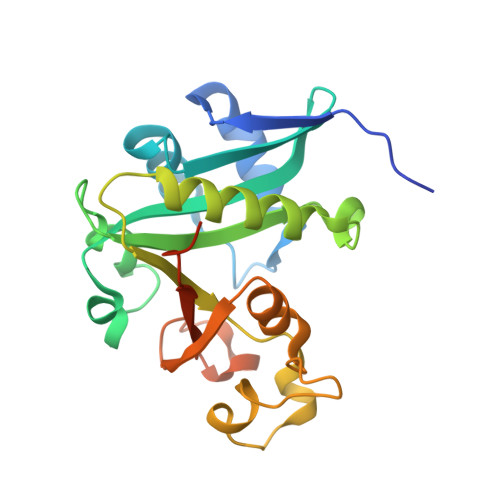GNAT-like strategy for polyketide chain initiation.
Gu, L., Geders, T.W., Wang, B., Gerwick, W.H., Hakansson, K., Smith, J.L., Sherman, D.H.(2007) Science 318: 970-974
- PubMed: 17991863
- DOI: https://doi.org/10.1126/science.1148790
- Primary Citation of Related Structures:
2REE, 2REF - PubMed Abstract:
An unexpected biochemical strategy for chain initiation is described for the loading module of the polyketide synthase of curacin A, an anticancer lead derived from the marine cyanobacterium Lyngbya majuscula. A central GCN5-related N-acetyltransferase (GNAT) domain bears bifunctional decarboxylase/S-acetyltransferase activity, both unprecedented for the GNAT superfamily. A CurA loading tridomain, consisting of an adaptor domain, the GNAT domain, and an acyl carrier protein, was assessed biochemically, revealing that a domain showing homology to GNAT (GNAT(L)) catalyzes (i) decarboxylation of malonyl-coenzyme A (malonyl-CoA) to acetyl-CoA and (ii) direct S-acetyl transfer from acetyl-CoA to load an adjacent acyl carrier protein domain (ACP(L)). Moreover, the N-terminal adapter domain was shown to facilitate acetyl-group transfer. Crystal structures of GNAT(L) were solved at 1.95 angstroms (ligand-free form) and 2.75 angstroms (acyl-CoA complex), showing distinct substrate tunnels for acyl-CoA and holo-ACP(L) binding. Modeling and site-directed mutagenesis experiments demonstrated that histidine-389 and threonine-355, at the convergence of the CoA and ACP tunnels, participate in malonyl-CoA decarboxylation but not in acetyl-group transfer. Decarboxylation precedes acetyl-group transfer, leading to acetyl-ACP(L) as the key curacin A starter unit.
- Life Sciences Institute, University of Michigan, Ann Arbor, MI 48109, USA.
Organizational Affiliation:

















